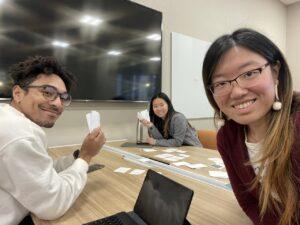Game Designers: Shana Hadi, Nick Feffer, Charlotte Feng
We live in an era where corporations “trade in human futures” (Shoshana Zuboff).
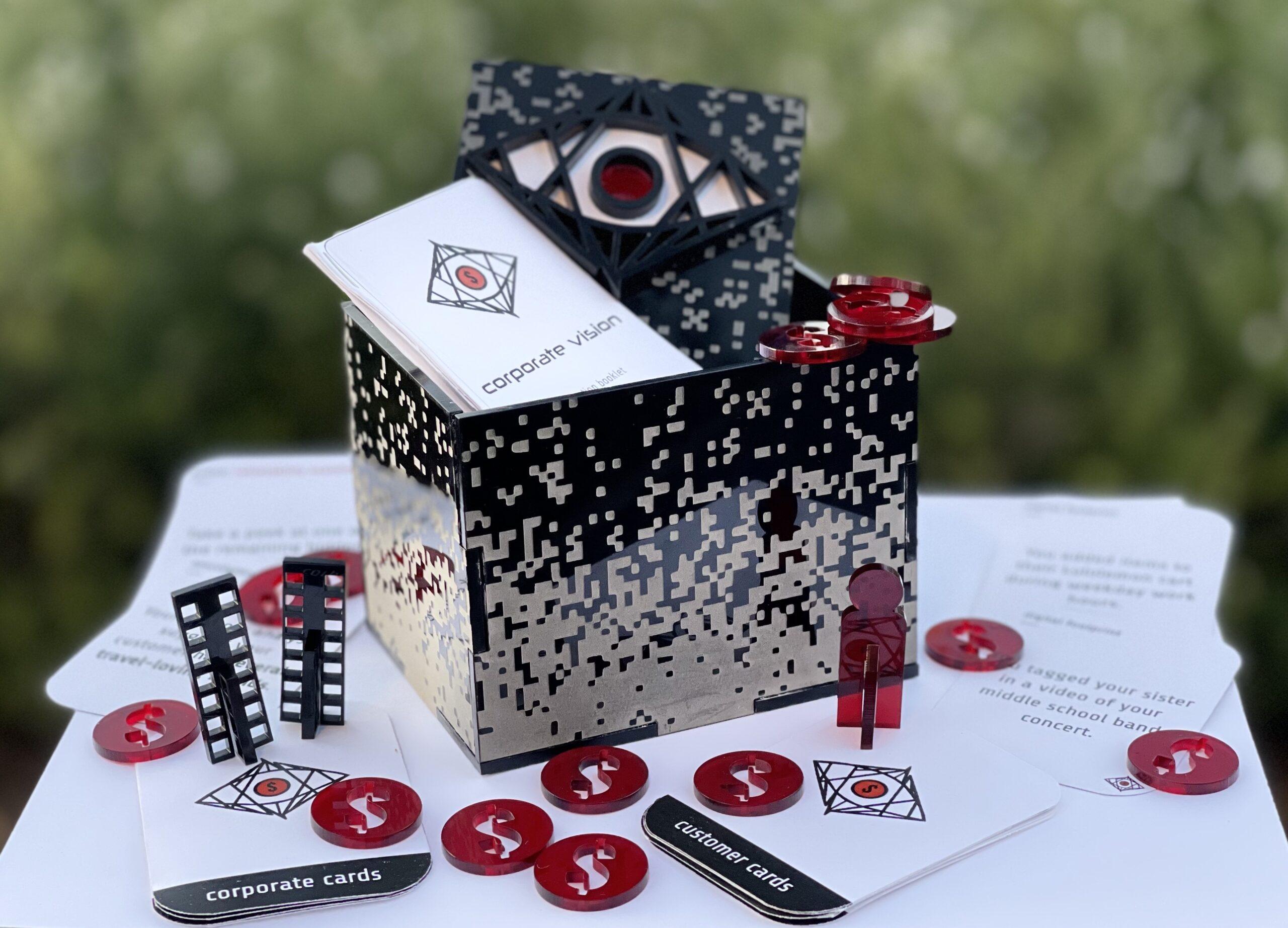
Premise
corporate vision is a competitive social game (3-5 players) that teaches how corporations can use customers’ digital footprints to construct personas for more accurate targeted advertisements, contributing to the rise of what Professor Shoshana Zuboff calls “surveillance capitalism.” In this game, one player will act as the customer, while the others will act as corporations who will speculate on the customer’s digital footprints and use them to create advertisements targeted to the customer. The customer judges the pitches and awards engagement tokens to the corporation with the best personalized pitches, using the criteria of persuasiveness and logical justification based on the available data points.
Context
As Zuboff describes in her book The Age of Surveillance Capitalism, global tech companies like Google and Meta have persuaded us to give up privacy for the sake of convenience, and they trade our personal information (“data”) to help advertisers not only predict our behavior, but influence and modify it.
This “new economic order” has spread from data collection on tech platforms to surveillance-based ecosystems across every economic sector, largely because of the strong economic imperatives that drive “smart,” “personalized,” behavior-predicted products.
Data has become this century’s most important capital.
Learning outcomes
Hence, we hope to do the following:
- Help raise awareness of how corporations use your digital footprints to predict and influence your future purchases.
- Model the predictive algorithmic system by which corporations can make accurate speculations about you as a consumer, based on your data and digital footprints.
- Inspire conversations on digital surveillance and its inextricable links with capitalism, so that we can guard against its influence more effectively and advocate for collective protections.
Types of fun
Because corporate vision hopes to impart greater knowledge of digital footprints and to provide players the opportunity to practice modeling the behind-the-scenes interactions involved in constructing a customer persona and creating a targeted advertisement, we designed corporate vision to have fellowship, expression, and narrative as the main types of fun.
Fellowship: Several players are brought into the “magic circle” game world that models real-world economic interactions between corporations and customers, and corporations with each other.
- Players act as corporations competing to win the attention of the customer by personalizing their targeted advertisements. (One customer playtester noted, “I loved feeling like the center of attention.”)
- Corporations can also play action cards, such as changing public digital footprints and partnering with another corporation to share cards, to affect each other’s performance. (Two corporation playtesters joked, “I think we accidentally formed a new world order together.”)
- Most importantly, because players take turns acting as corporations and customers, they experience both sides of the attention economy, building experience and understanding of this socioeconomic framework.
Expression: Corporation players collect speculation cards and use them as a basis for making custom, personalized pitches — and products — they believe will win over the customer.
Narrative: All players construct a predicted persona of the customer, and because each corporation’s committed speculation is public at the end of every round, players can also speculate on each corporation’s predicted persona and pitch. We have also observed (in at least four playtests) that players often joke about the collective persona created by all the speculation cards, leading to intricate backstories for the extremely multifaceted customer persona (“a got-rich-quick retired engineer looking for love with other ‘suburban disasters,’ while on the run from their debts by going on a cruise to the Caribbean”).
Humans naturally tell stories. : )
(Sensation: We made theming choices to emphasize the subtle insidiousness and shiny allure of surveillance capitalism — personalized advertisements that “fit” you, at the cost of your data privacy — with the prominent caged red eye and reflective, shiny tokens reminiscent of Koons.)
Rules
(We include the premise from the previous section again for clarity.)
(corporate vision is a competitive social game (3-5 players) that teaches how corporations can use customers’ digital footprints to construct personas for more accurate targeted advertisements, contributing to the rise of what Professor Shoshana Zuboff calls “surveillance capitalism.” In this game, the player will act as the customer, while the others will act as corporations who will speculate on the customer’s digital footprints and use them to create advertisements targeted to the customer. The customer judges the pitches and awards engagement tokens to the corporation with the best personalized pitches, using the criteria of persuasiveness and logical justification based on the available data points.)
Roles

Customer
1 player is the customer. At the beginning of a round, the customer draws 5 customer cards, each containing a digital footprint. These will be later revealed to the corporations. From these footprints, the player must envision themselves as the customer who would leave these footprints.
After all rounds are played, the corporations will pitch an advertisement to the customer. The customer must then judge the pitches and declare a winner to earn engagement. Judging criteria is based on how likely the customer would be to engage with the advertised product.
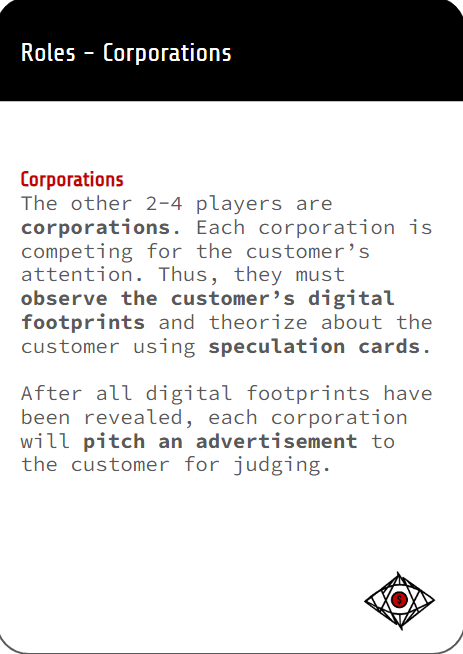 Corporations
Corporations
The other 2-4 players are corporations. Each corporation is competing for the customer’s attention. Thus, they must observe the customer’s digital footprints and theorize about the customer using speculation cards.
After all digital footprints have been revealed, each corporation will pitch an advertisement to the customer for judging.
Gameplay
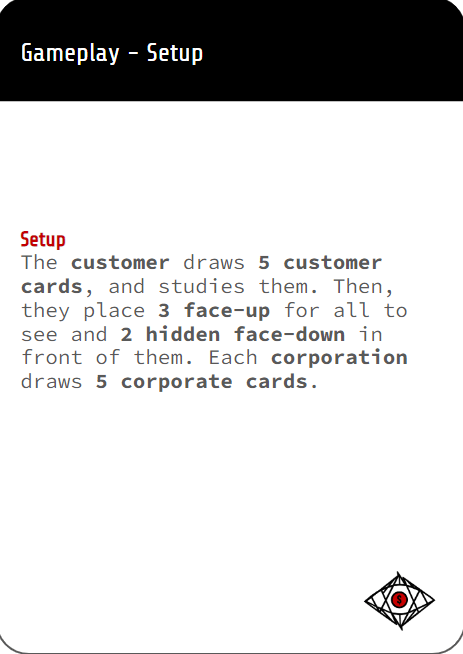 Setup
Setup
The customer draws 5 customer cards, and studies them. Then, they place 3 face-up for all to see and 2 hidden face-down in front of them. Each corporation draws 5 corporate cards.
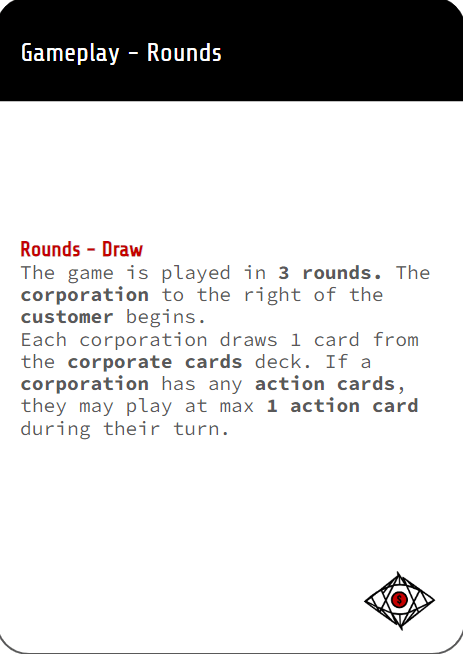 Rounds – Draw
Rounds – Draw
The game is played in 3 rounds. The corporation to the right of the customer begins.
Each corporation draws 1 card from the corporate cards deck. If a corporation has any action cards, they may play at max 1 action card during their turn.
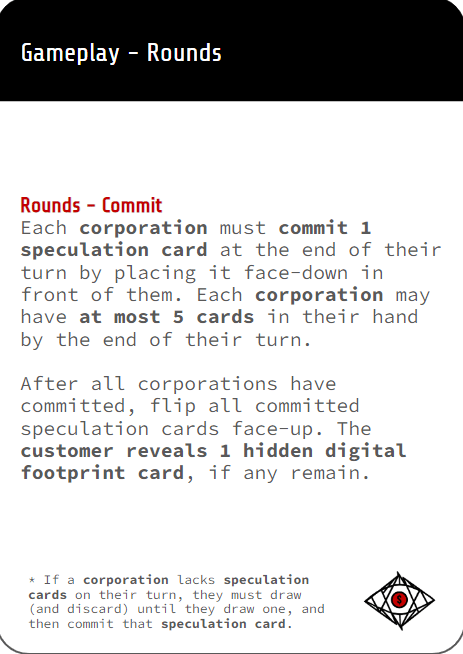
Rounds – Commit
Each corporation must commit 1 speculation card at the end of their turn by placing it face-down in front of them. Each corporation may have at most 5 cards in their hand by the end of their turn.
After all corporations have committed, flip all committed speculation cards face-up. The customer reveals 1 hidden digital footprint card, if any remain.
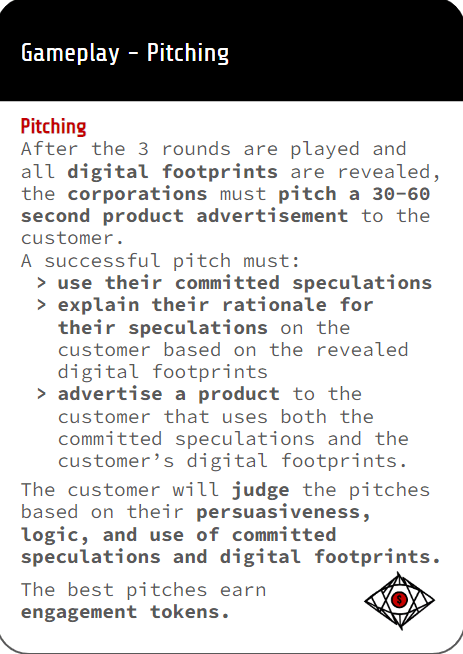
Pitching
After the 3 rounds are played and all digital footprints are revealed, the corporations must pitch a 30-60 second product advertisement to the customer.
A successful pitch must:
- use their committed speculations.
- explain their rationale for their speculations on the customer based on the revealed digital footprints.
- advertise a product to the customer that uses both the committed speculations and the customer’s digital footprints.
The customer will judge the pitches based on their persuasiveness, logic, and use of committed speculations and digital footprints. The best pitches earn engagement tokens.
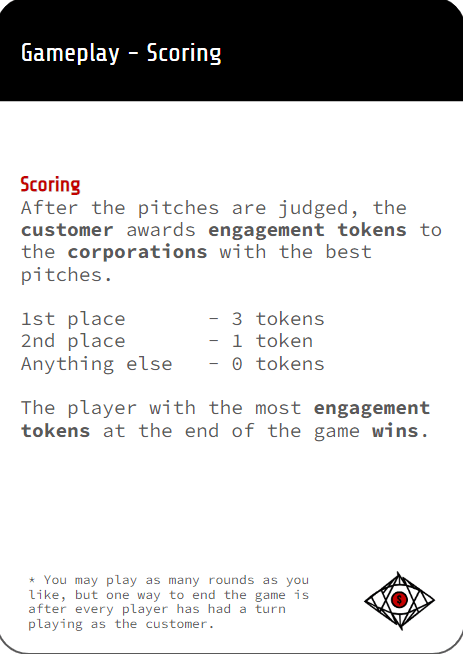
Scoring
After the pitches are judged, the customer awards engagement tokens to the corporations with the best pitches.
- 1st place: 3 tokens
- 2nd place: 1 token
- Anything else: 0 tokens
The player with the most engagement tokens at the end of the game (keep playing as many rounds as you like!) wins.
 Gameplay – Layout
Gameplay – Layout
Shown here is the layout of the game at the start, prior to any rounds being played.
Game Bits & Print and Play
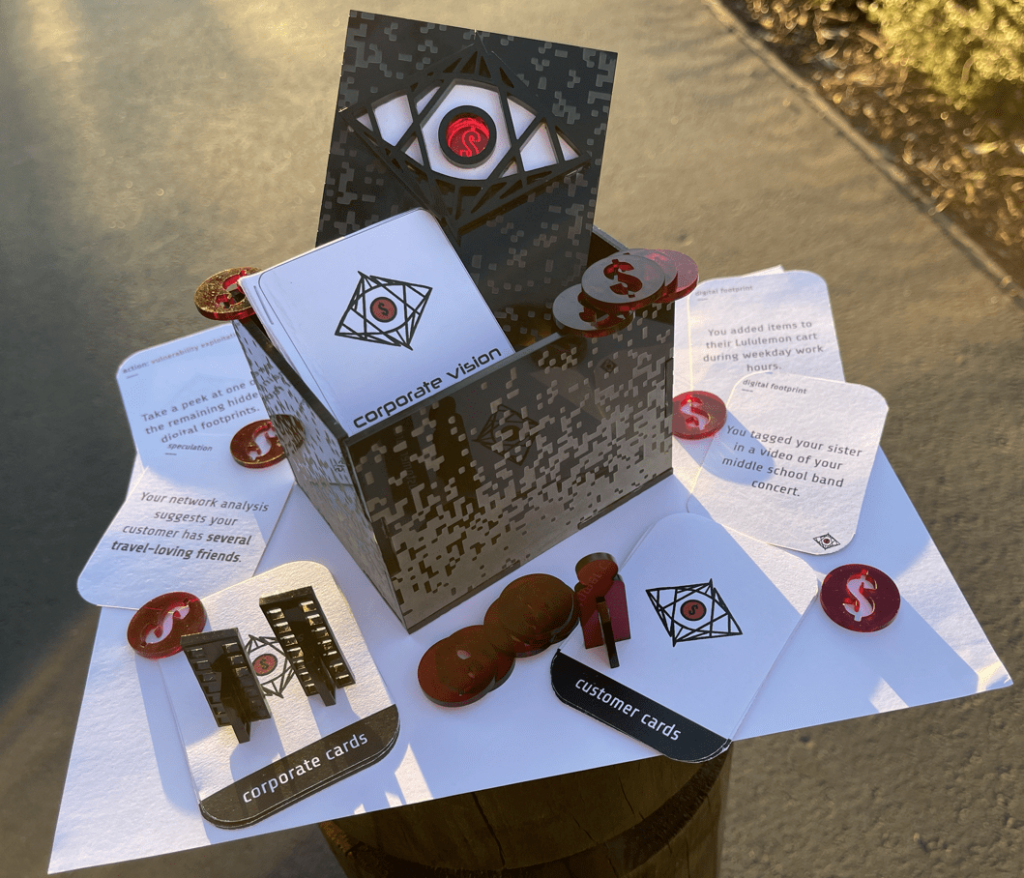
Here is a link to a printable version of our game.
[https://drive.google.com/file/d/1dEAOH-MBg1HWI2W0FDK3k0kWqPEbmin_/view?usp=sharing]
Materials include:
- Custom laser-cut box
- Instructions booklet
- Premise and discussion cards
- 45 customer digital footprint cards
- 45 corporation speculation cards
- 18 corporation action cards
- 36 red engagement tokens (money)
- 1 red customer token (person)
- 4 black corporation tokens (buildings)
Examples of the digital footprint (customer), speculation (corporate), and action (corporate) cards.
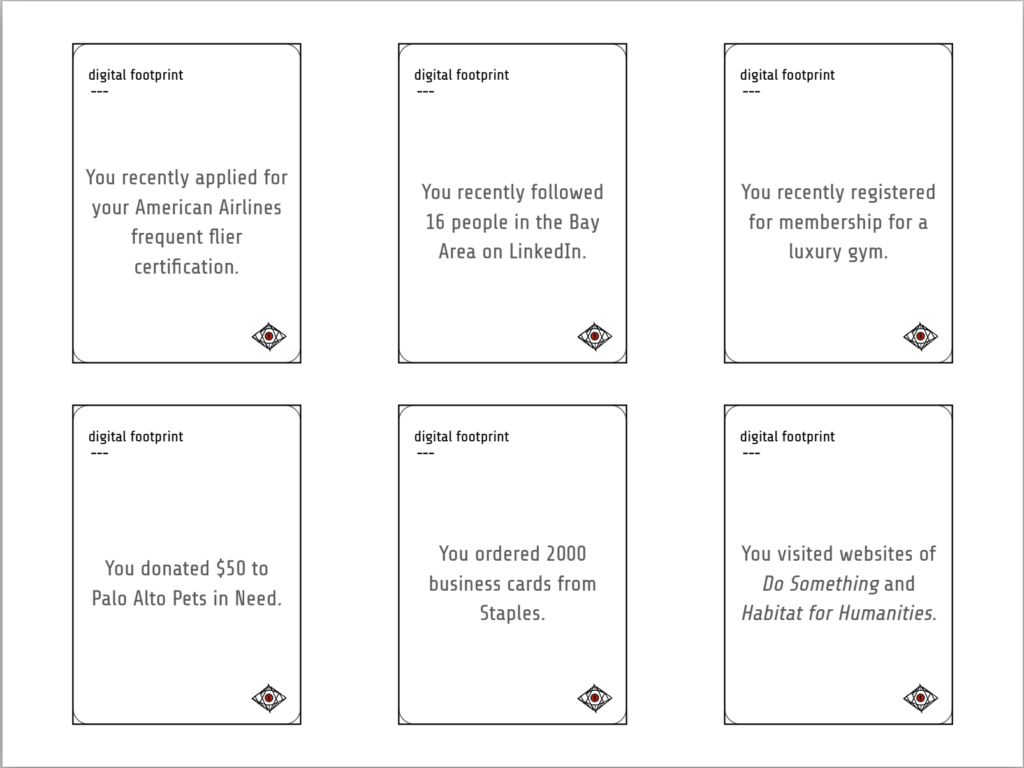
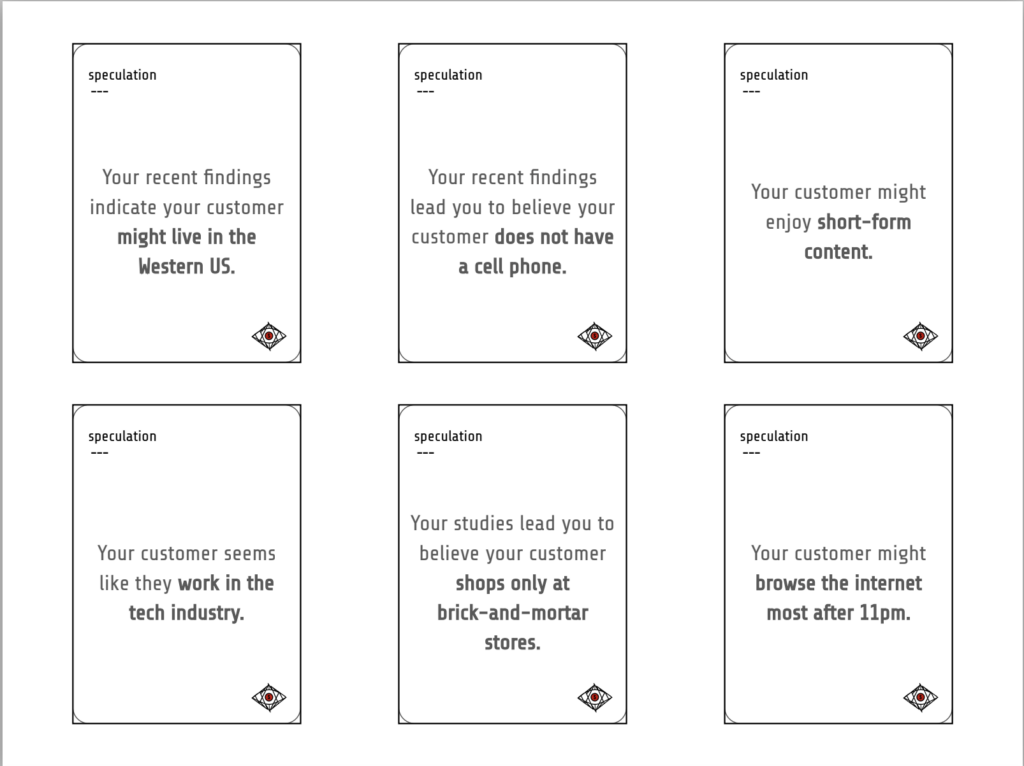
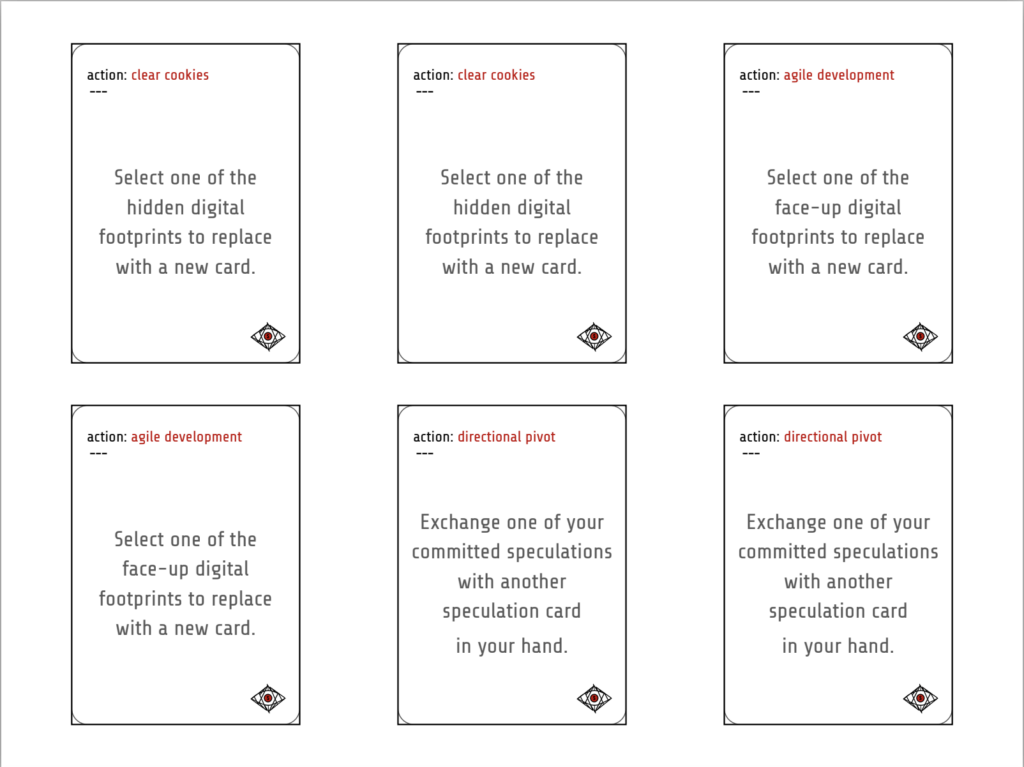
Assessment
(We refer to the learning outcomes from the previous section again for clarity.)
- Help raise awareness of how corporations use your digital footprints to predict and influence your future purchases.
- Model the predictive algorithmic system by which corporations can make accurate speculations about you as a consumer, based on your data and digital footprints.
- Inspire conversations on digital surveillance and its inextricable links with capitalism, so that we can guard against its influence more effectively and advocate for collective protections.
We measured our learning outcomes and effectiveness of our game through these two qualitative assessments:
- Observing players’ comments on their digital footprints and corporate speculations during gameplay.
- Explicitly surveying players’ views on digital footprints at the end of the game, and noting any provoked conversations.
1. Raising awareness of digital footprints
The most common feedback (given to us in all 5 playtests) was how gameplay, especially with the specificity of our customer cards (recall that in corporate vision, customer data is currency), reminded our players of their own digital footprints, including what / when / where they purchased items, signed up for accounts and newsletters, engaged online, and more. For example, a tester in Playtest 2 (external) exclaimed, “This is me! I just got this last week!” when they saw the card, “You just earned a free book with thriftbooks rewards. Congratulations!” We unofficially followed up with players from two different playtests two days later, and they remarked on their continued increased awareness, with one noting that they had made a new private Twitter account as a result of an in-game conversation about messed up home feeds.
2. Model the predictive algorithmic system of speculative targeted advertising
We also observed that when players acted as corporations, they also became more conscious of “the narratives we could make using these cards [as data points]” (Playtest 3, external), with one player citing the Target pregnancy prediction story, and others noting, “Makes me think about what is being viewed by the companies … and my own data usage” (Playtest 1, in-class). In Playtest 2 (external), a player remarked on the corporation cards, “These are stereotypes,” to which another player responded, “That’s exactly how the companies see us.”
As a corollary goal, some players “identified” with the corporations and the economic incentives underpinning surveillance capitalism, with one player noting, “The digital footprints and gameplay helped me get into the mindset of corporations, which led so naturally to trying to persuade the customer as I gathered more data points” (Playtest 3, external).
3. Inspire conversations on digital surveillance
Lastly, as time permitted, we saw gameplay evolve naturally into conversations about social media usage and online tracking, with a few jokes. For example, in Playtest 3 (external), one player passionately pulled up their Twitter feed to show how they were receiving niche, radical content about a fandom which they theorized was from them accidentally following a troll bot for several months. This then led to a larger conversation about radicalization through YouTube and aligned economic incentives for user engagement.
*Due to the limited time (~30 minutes) for in-class playtests, we measure our effectiveness in this learning outcome by our observations in our two external playtests.
Iteration history (5 rounds)
We had 5+ different iterations with 5 playtests (3 in-class, 2 external, several in-team) and 1 design review with external participants. Our largest changes involved the turn-based visibility of customer digital footprints to all players, the balance of corporation action cards, codification of the pitching mechanism and other rules, and the improved fidelity of our pieces which added sensory fun to our playtests.
* We made a modest attempt to anonymize the data by not using names or specific details.
* We made liberal use of the RITE method and added mods in-between playtests and occasionally in-game.
Iteration 1: Class 2B (~20 minutes)
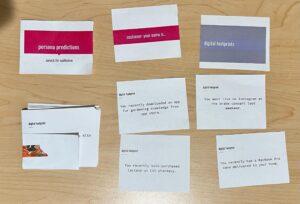
We ran this playtest in class with three classmates (2 F, 1 M, all in their early twenties), with rules, observations, and results further described in our blog post here (https://mechanicsofmagic.com/2023/01/19/p1-persona-predictions-2b-playable-prototype/).
Problem 1: We originally had corporations only reveal their digital footprints at the end of all three rounds, but this led to confusion on the purpose of action cards because corporation players did not know who to target, since they could not predict the other corporation players’ “persona angle” until the end.
- Next change: Each corporation must now commit a speculation at the end of their turn (face-down), and once everyone has gone in the turn, all speculation cards are revealed. This adds an additional gameplay mechanic of predicting other corporations’ personas, strengthening the power of action cards for sabotage, and scaffolding the final pitch with how corporation players must use their personal speculation cards for their pitch.
Problem 2: The customer player wanted a more equal role to the corporation players, including greater intentionality for the digital footprints.
- Next change: We decided to allow the customer to select which 3 of the 5 footprints would begin face-up, but as the customer player also noted, “I get personal satisfaction from the people pitching to me,” and the game is intended to move quickly so each player has a turn in both roles, we continued to limit the powers of the customer, similar to Apples to Apples. We also added a 20-second pitch limit.
Iteration 2: External, Jan 20 (~30 minutes)
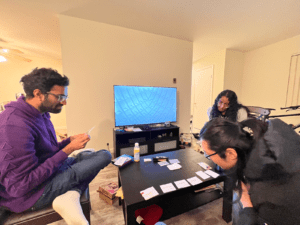
We ran this playtest with three external friends (2 M, 1 F, all in their early twenties).
Overall, the playtesters found the game fun, and reported that this game made them think of “how the companies see them.” There was lots of laughter when players sabotaged each other by replacing the public digital footprints. When one of the digital footprints changed, the playtesters’ constructed personas had to change too, and the resulting good-natured groans led to increased engagement; this helped justify our changes from iteration 1.
Problem 1: The first playtest took quite long to finish a round (20+ minutes), and we wanted to speed up the game by limiting each pitch to 20 seconds. However, playtesters protested the very short time limit for their spun narratives, and each playtester still took more than one minute to pitch.
- Next change: We made the pitch time limit to 30-60 seconds.
Problem 2: Action cards seemed inapplicable (such as the skipping a player’s turn, especially with the 3-turn limit per round) and could be more strongly tied to the theme. Corporation players also noted the possibility of having too many action or data insight cards, with an anomaly of how one player played several action cards in one turn, which broke the game balance for the other players.
- Next change: We limited each turn to playing a maximum of 1 action, and tried to split the corporations’ action and data insight cards to different decks to try the resulting game balance.
Iteration 2.5: Designer playtest – Jan 23
In this playtest, the three corporate vision designers came together to experiment with several changes:
- Thematizing our action cards to a corporate feel, such as “agile development” or “cloud storage upgrade,” which added greater cohesiveness to the game model and theme.
- We experimented with separating the action cards and data insights cards into two decks, and letting the player choose to pick an action card and/or a data insight card. We found that this setting made the turns more confusing and slow-paced, with less of the joy of having a surprise action card appear in your hand. We decided to backtrack, and put action cards and data insight cards back into one corporation deck.
- We also printed out the instructions for faster “spin-up,” and also so that we could test the clarity and information design of our instructions in future playtests.
Iteration 3: External, Jan 23 (~50 minutes)
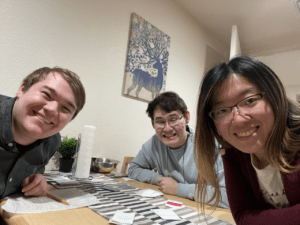
We ran this playtest with two external friends (2 M, both in their early twenties) and one designer, and played through several rounds so that each player acted as corporation and customer at least once to model a full game.
Our changes so far with the solidified mechanics and explicitly written instructions led to faster gameplay, with ~10 minute rounds, and the customer still felt involved and “catered to” as part of the pitches. The cohesive theming of the cards also lent themselves well to usage for heavily narrative-based gameplay, with fascinating in-depth backstories for the customer, including jokes about the customer wondering, “What’s more important in my life, romance or my ego?” and “how can I escape my debts? By going on a long Caribbean cruise.”
Problem 1: The instructions on one page helped, but there was initial confusion with how to set-up the card decks, and how the roles and final pitching would ensue.
- Next change: We created a diagram with a set-up layout to inform future playtests, and added graphics that would help reduce cognitive load and improve the speed of information intake for faster instructions to gameplay transition.
Problem 2: We had a few minor instruction clarifications, such as how you can have up to 5 cards in your hand, recommendations on how to judge the pitch (persuasive and logical from the available data), which we fixed by the next playtest.
Iteration 4: Class 3A, Jan 24 (~25 minutes)
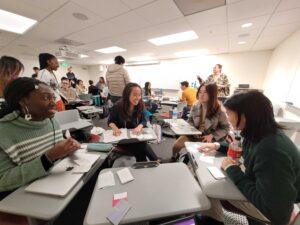
We ran this playtest in class with four players (4 F, all in their early twenties).
Players said this game already “felt very polished” and that it was already a “very good party game,” and they seemed very engaged in the gameplay, with various trills of laughter. Corporations played off each other during the turns and made use of the updated action cards, and the customer also confirmed, “I like my job, I’m still invested.”
Most of the feedback we received from players and instructors involved the theming, text phrasing, and fidelity, and smaller improvements and clarifications, which include the following:
- Players noted confusion with the “digital footprint” vs. “data insight” cards for the roles, so we rebranded it to specifically “customer” and “corporation” cards.
- Players also noted how “digital footprint” cards were “truths,” while “data insight” cards were “maybes,” so we rebranded the data insight cards to “speculation” to indicate the literal predictive (and speculative) actions of the corporations, and how those predictions were not necessarily fact, just the scaffold for the final pitches.
- Christina noted the natural expectation to have physical tokens for the win points, a “reward for a good ad,” which we acted upon in our design update.
4.5 “Look and feel” design review – Jan 25
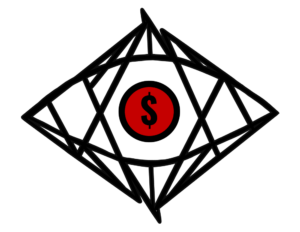
After our most recent playtests, our biggest point of improvement was the physicality of tokens and the cohesiveness of our theming and design, especially as our game uses data (the text statements) as the literal in-game resource and currency. Thus, we made major appearance changes to the game, including designing various vector illustrations, a bit graphics background, logo, multilayer friction fit laser-cut black box with 3D components (a complex all-day process), and hand-cut cards with rounded corners.
We interviewed two external students for feedback on the design. After explaining the premise of the game, we asked questions about the game’s look and feel. We gained some useful insights, including that the new color theme (white, deep red, and black) and the creation of the eye logo changed the game’s whole mood. Specifically, the blood-red makes the corporations seem more “sinister” and the eye evokes feelings of Bentham’s panopticon – that corporations are always watching their consumers. While it could be argued that corporations are not inherently evil for trying to optimize their business model, these aesthetics are in line with our teaching goals, as we set out to make players more mindful of their digital footprints and to think carefully about what they allow companies to see. Another student remarked on how the design, especially the all-seeing eye, leads to a “creeping” feeling with the contrast between the lighter pitching and the underlying reality of how corporations use digital footprints, and ultimately concluded that it strikes a subtle, “insidious” tone that reflects the nature of how personalized ads may seem “like a good thing,” but actually embody a violation of privacy.
Thus, our design choices overall contribute to an increased coherence across theming, learning outcomes, and mechanics.
Iteration 5: Final, for now, class 3B (~25 minutes)
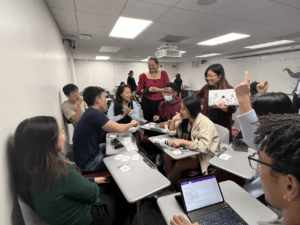
To give as many people as possible an opportunity to play (and to observe the potential chaos), we ran this playtest in class with six!! classmates (4 F, 2M, all in their early twenties).
We observed a gloriously hectic — and thus, even more fun — playtest, with players who in-between drawing cards and playing actions, also built off of each other to jokingly create a collective “persona” with a variety of traits, based on the revealed cards and each corporation’s speculations. By the pitch section, the customer was described in various terms, such as an “educated baddie,” “a music nerd,” “a girl who takes care of herself and jetsets with an on-off romantic relationship,” “a surface-level rich girl who’s poor as f and really wants budgeting help,” and so on. One player joked that, “Companies are salivating over this obviously consumerist customer,” and laughter was heard across all the turns, with some mild (for-fun) sabotage with the publicly available digital footprints changing several times, forcing the corporations to switch persona strategies and potentially sabotage other players’ cards.
Though the time was cut short out of fairness, corporation and customer players reported that they enjoyed the game. We received some recommendations on how to further clarify the rules (such as edge-cases, like what happens when you replace hidden digital footprints) and suggestions on how to improve the “sharing hands” action card and customer roles.
Overall, a lot of fun to watch!
Next steps
In a future version of this game, we would be interested in exploring the following:
- A game mat with designated sections for the cards
- Further mods, such as an in-game market to use engagement tokens (the currency won from a good ad) for future action cards
- Increased intentionality options for the customer to construct their persona out of the digital footprints
- A far greater number of customer and corporation cards for increased replayability
Design Aesthetic
All made by hand, including vector tracing, corner cutting, box laser-cutting and gluing, token creation, and more!
Big Brother “all-seeing eye” + “black box” algorithm + “subtly insidious black, white, and red” + “corporate view of data as material” + “sheer joy of sensorily playing with stackable acrylic (and recyclable) tokens”
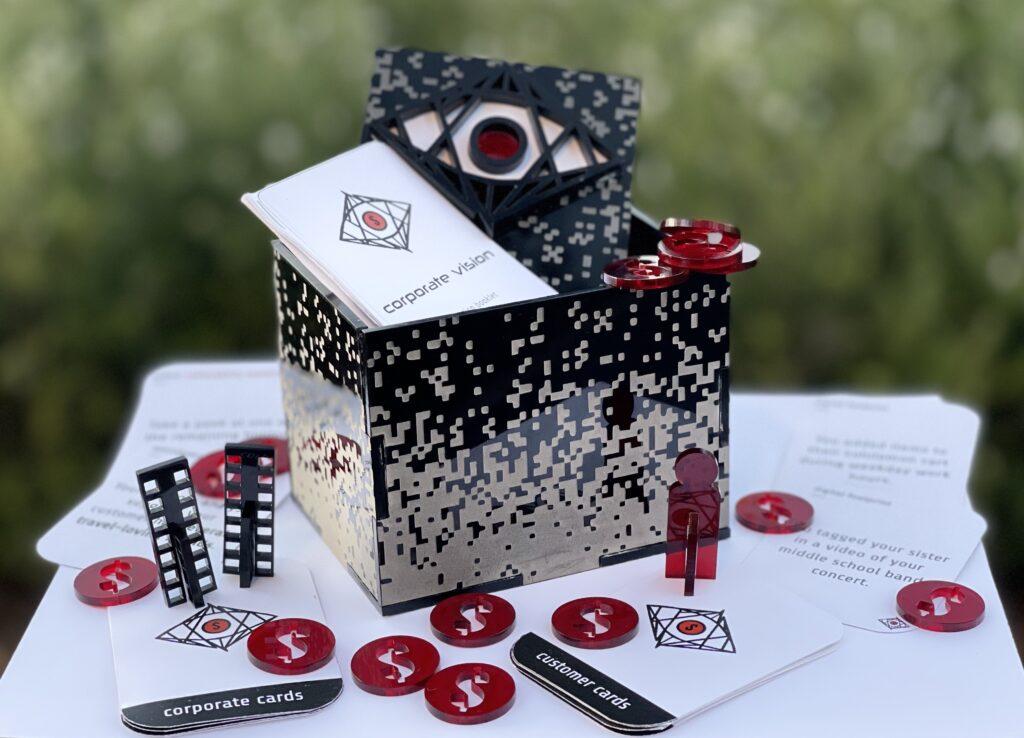

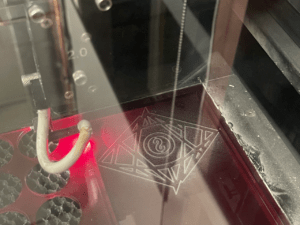

We had several design decisions that we would be happy to further discuss! : )
- Color scheme
- The “subtly insidious” black, white, and red color scheme is linked to the phrase “blood money” and adds to the sinister color scheme, even as black and white are the usual mode for corporate documents.
- Logo
- A Big Brother “all-seeing eye” which refers to Bentham’s panopticon – corporations are always watching their consumers – and also appears on every card.
- The eye also represents attention and intention, with how under surveillance capitalism, “data is currency” and targeted advertisements are a form of influencing the consumer “attention economy.”
- The red eye is taken over entirely by red and a dollar sign, a metaphor for corporate greed and economic incentives to produce profit, until it takes over other communal goals.
- A black diamond-like cage covers the eye, indicating the structures of capitalism and society that have led to our current state.
- (Bonus: while we knew we wanted to have all these elements, we also used a Big Data product, Stable Diffusion, to help brainstorm, and our act of doing so additionally refers back to our game premise of how corporations can use our private data and images, and further adds coherence to our design, as the process is part of the art. Note that we still drew our logo by hand.)
- Box
- The box is a friction fit (and glue) laser-cut and engraved box, made to hold our cards and extra tokens. (Shana has potentially inhaled fumes as a result, hahaha, actually maybe >.<)
- It is black with a bit gradient that diffuses upwards to refer to how “big data” is often termed a “black box” with how AI uses a variety of inputs and weighing to produce outputs, similar to the behavior that corporate vision models with corporation players constructing personas, and the bit gradient refers back to the corporate view of “data as material” and how we associate our data as encoded in square bits.
- We also chose reflective instead of matte black to link back to ideas of “shadowy reflections in our technology,” but yes, the coolness factor was a larger consideration, especially with the bit texture in contrast.
- The eye cage is laser-cut and protrudes on top to more viscerally indicate the structures that trap us and our attention.
- We considered putting the title below the eye, but decided on a clean, polished look for the aura of mystery (and to preserve sleekness).
- The top lid has a hole cut out of the center, with the back of the lid = an engraved red acrylic sheet with the dollar sign in the eye, so that when you hold up the lid to the light or catch it at the right angle, it flashes red (Big Brother is always watching!).
- We were interested in exploring notions of transparency, with how you can use the cutout to look directly into the box and the inner materials, albeit with the dollar sign literally blocking your view.
- Tokens
- While we were making the box, we drew upon our sheer joy of sensorily playing with stackable acrylic (and recyclable) tokens, which led to making building icons and player icons in-between cuts.
- As the red eye with the dollar sign is part of our logo, we used the pupil with a cut-out dollar sign for the “engagement tokens” received for winning an advertisement pitch, as it both combines ideas of 1) attention economy and 2) actual currency.


